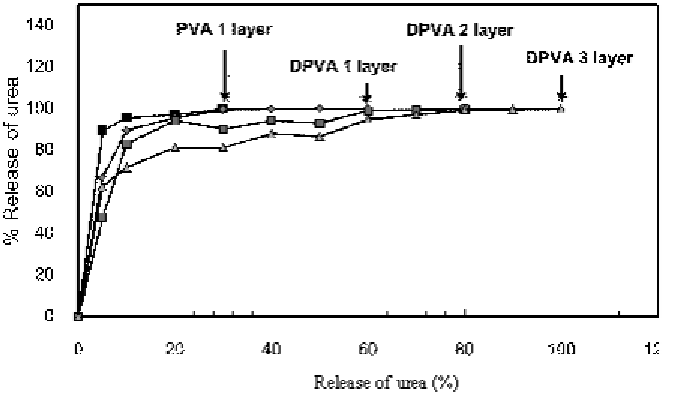Agriculture Reference
In-Depth Information
effect of the release rate of urea from the beads coated with the different layers of PVA/St/NR
blend is presented in Figure 27. It is obvious that the release rate for urea was reduced
significantly by an increase in the modified PVA coating layer, which is consistent with the
results of the swelling study. The modified PVA film is very strong, rigid and hard to swell,
so the diffusion through this coating is the rate-limiting step for the swelling and urea release.
These phenomena may perhaps be explained by the difference in swellability of the
PVA/St/NR blend matrices as shown in Figure 26. The bead coated polymer blend with a thin
coating layer can diffuse rapidly and be quickly released.
The cumulative release of urea from the capsule was derived from different immersion
times at 3, 10, 20 and 30 h in an aqueous medium. The release rate was 8, 60, 81 and 95%,
respectively. When the polymer blend was coated onto the capsule with an increase of 1 to be
3 layers, the urea was cumulatively released from the stored capsule was 2, 29, 59 and 82%,
respectively, under the same conditions. It must be noted that with an increase in the
PVA/St/NR coating, the capsule matrix became denser, which resulted in a decrease in the
rate of diffusion of urea through the swollen beads, especially the beads with a third-
modified PVA/St/NR blend coating.
This result supported the results of Li Chen and co-
worker (Chen, 2008). The St-g-PLLA exhibits a relatively low swellability, a large
encapsulating capacity, and a slow-release rate. The water-resistance of the matrix could be
improved by increasing the efficiency of the PLLA graft onto the St granules as described
above.
Figure 25. Percentage of the cumulative urea release from beads coated with PVA and DPVA.
3.6. Encapsulated FertiliserFertilizer with NR-g-St
First, the urea exposed on the surface of the bead could be removed completely by
washing with water. It was clear that the urea release rate was significantly reduced by the
NR/St blend coating, compared to the St coating, which is consistent with the results of the
swelling study as displayed in Figure 29. The NR/St blend membrane is very strong and hard



Search WWH ::

Custom Search